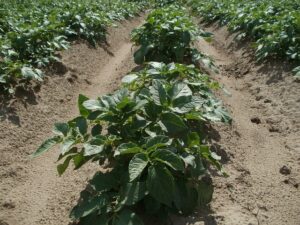
Introduction
It’s time to harvest your potatoes once the foliage turns yellow and begins to die back. This indicator, coupled with the readiness of the tubers—you should be unable to rub the skin off easily—heralds the perfect time for a bountiful harvest! This is how you know when to harvest potatoes.
Brief Overview of Planting Potatoes
Cultivating potatoes is a rewarding process that involves several stages. It commences with chitting, where seed potatoes are placed in a light, frost-free spot to sprout. Once the risk of frost has passed, these sprouted potatoes are planted in rich, well-drained soil. Regular watering and earthling up to prevent exposure to sunlight are vital to ensure healthy growth. Potato plants flower midway through the growing season, indicating tuber formation. As mentioned earlier, the harvest takes place when the foliage yellows and dies back. Overall, successful potato cultivation hinges on good preparation, diligent care, and timely harvest.
Understanding Potato Growth Stages
Potato growth can be divided into five distinct stages. The first stage, sprouting, initiates when the potato ‘seed’ is planted in the soil and begins to sprout. In the second stage, the vegetative phase, the plant develops leafy foliage and a strong root system. The third stage, tuber initiation, sees the plant start to redirect its energy from the foliage to creating tubers underground, which is the actual ‘potato’ we consume. In the fourth stage, tuber bulking, the tubers grow in size, accumulating starch and nutrients. The final stage is maturation, where the foliage dies back, signaling readiness for harvest. Understanding these stages can greatly enhance the success of your potato cultivation efforts.
Growth and Development Stages
The growth and development stages of a potato plant are crucial in determining the timing and manner of cultivation.
- Sprouting: This stage begins when the potato ‘seed’ is planted in the soil, and the plant starts sprouting.
- Vegetative Phase: As the plant grows, it enters the vegetative phase. In this phase, the plant develops leafy foliage and a strong root system that supports its growth.
- Tuber Initiation: The plant then enters the tuber initiation stage. The plant redirects its energy from the foliage to creating tubers underground.
- Tuber Bulking: Following the initiation phase, the plant enters the tuber bulking stage. The tubers grow in size, storing starch and other nutrients.
- Maturation: The final stage of growth is maturation. The foliage begins to die back, signaling that the tubers are ready for harvest.
Understanding these stages is essential for successful potato cultivation, as the health and yield of the crop depend on how well each stage is managed.
Signs of Potato Readiness for Harvest
The size of the tubers is an important indication of harvest readiness. Generally, you can start harvesting once the tubers have reached the desired size. For new potatoes, this is typically when they’re about the size of a hen’s egg.
The condition of the potato plant’s foliage is another key determinant. When the foliage turns yellow and begins to die off, it’s usually a sign that the potatoes are ready for harvest. This is the plant’s natural mechanism to signal that the tubers are mature.
Additionally, keeping track of the time since planting is crucial. Most potato varieties are ready for harvest about 10-12 weeks after planting. However, this can vary depending on the specific variety and growing conditions. Hence, it’s a good practice to check the maturity time suggested for the variety you’re growing.
Determining the Right Time for Specific Purposes
The ideal harvesting time for potatoes can vary depending on your specific needs. For instance, if you want ‘new potatoes’, which are small and tender, you should harvest while the tubers are still young and the plant’s foliage is still green. On the other hand, if you’re looking for mature potatoes that store well, it’s best to wait until the foliage has completely died back, indicating that the potatoes have full maturity.
Procedure for Harvesting Potatoes
- Preparation: Prepare your harvesting tools. A pitchfork or a spade is commonly used to dig out the potatoes. Remember to be gentle to avoid damaging the tubers.
- Digging: Begin digging at the outer edges of your plant. Push your fork or spade into the soil about a foot away from the base of the plant, then lift the tool handle upwards to loosen the soil and reveal the potatoes.
- Harvesting: Once the potatoes are exposed, pick them up by hand. Be careful not to scratch, bruise, or puncture the tubers as this can lead to rot during storage.
- Cleaning and Curing: Brush off any soil clinging to the potatoes, but do not wash them just yet as water can promote rot. Allow them to cure for a few days in a cool, dark, and well-ventilated area to toughen up their skin for longer storage life.
- Storage: Store your potatoes in a cool, dark, and well-ventilated area. Proper storage can help your potatoes last for several months.
- Handling and Storage Considerations: After harvesting, potatoes should be left in a sheltered location to dry for a few hours. This process, known as curing, helps to toughen up the potato skins and extend their storage life. Once cured, brush off any remaining soil but resist the temptation to wash the potatoes, as moisture encourages decay. Store your harvested potatoes in a cool, dark, and well-ventilated place. Using hessian sacks or paper bags for storage can help to prevent light exposure, which would turn potatoes green and increase their solanine content, making them unsafe to eat. Avoid storing potatoes in the refrigerator, as the cold temperature can convert their starch into sugar, altering their taste.
Conclusion
In conclusion, harvesting potatoes requires both knowledge and skill. It’s essential to know when the potatoes have reached full maturity, which is often signaled by the complete die-back of the plant foliage. The process of harvesting involves careful preparation and execution. Start by preparing your tools—a pitchfork or spade is ideal. Begin digging from the outer edges of the plant, being mindful not to damage the tubers. Once harvested, clean the potatoes by brushing off excess soil, but avoid washing them immediately as moisture can promote rot. Let the potatoes cure in a cool, dark, and well-ventilated area to toughen up their skin, enhancing their longevity during storage. With these techniques, you can successfully harvest and store your potatoes, ensuring they remain fresh for several months.

